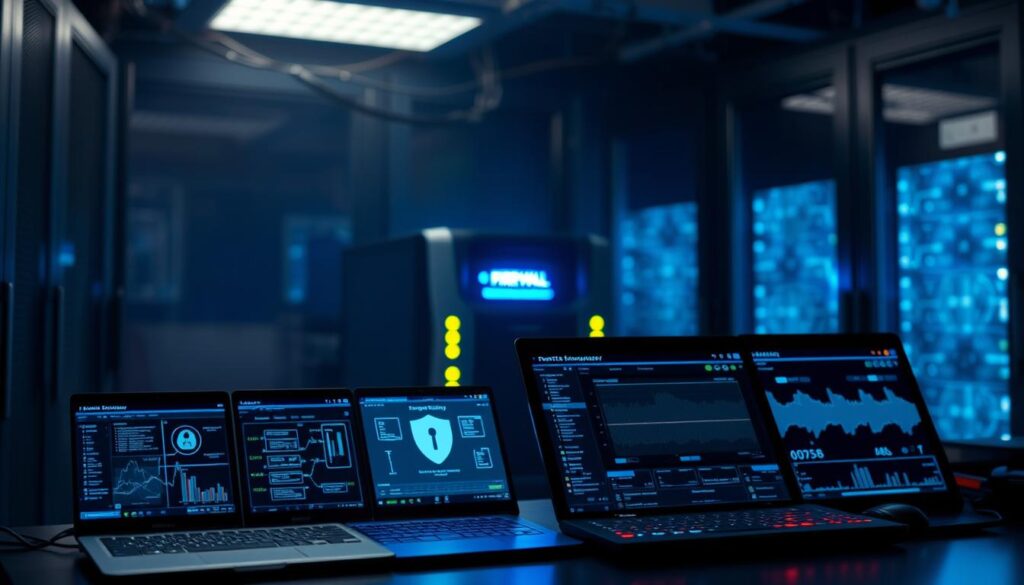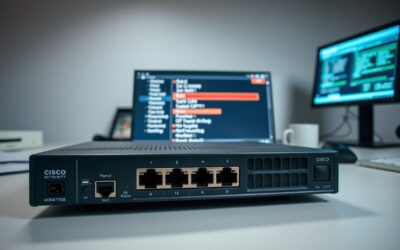Imagine your company’s data flowing through a maze of cloud apps, remote laptops, and unsecured Wi-Fi hotspots. Now picture a hacker slipping into that maze undetected. Scary? Absolutely. With 85% of organizations adopting hybrid work models, vulnerabilities in access controls and device management have skyrocketed. This isn’t just about firewalls anymore—it’s about mastering core principles to shield your infrastructure.
Why does this matter for CCNA professionals? Every time a user connects to a SaaS tool or accesses sensitive information from a coffee shop, risks multiply. The CIA triad—confidentiality, integrity, availability—is your compass here. Think of it as the golden rule: keep data private, uncorrupted, and accessible only to authorized users.
During a recent chat with a network engineer, they admitted, “I spend more time patching holes than building solutions.” Sound familiar? You’re not alone. This guide will unpack actionable strategies, from tools like VLANs to adaptive defense layers, so you can stay ahead of evolving threats. Let’s dive in.
Key Takeaways
- Hybrid work models and cloud adoption have increased exposure to breaches.
- The CIA triad framework is critical for balancing data protection and accessibility.
- CCNA exams prioritize security skills like access control lists and port security.
- Remote setups demand stronger authentication and traffic monitoring.
- Hands-on training (like EC-Council’s C|ND) bridges theory and real-world threats.
Understanding the Importance of Network Security
Picture this: you’re working from your favorite coffee shop, sipping a latte while accessing cloud data. Sounds ideal—until you realize the person next to you might be intercepting unencrypted files. With 43% of businesses experiencing cyberattacks targeting remote workers last year, that cozy café becomes a risk zone. Modern workstyles demand smarter protection strategies.
What Makes Digital Protection Crucial Now?
Data breaches jumped 72% since 2020, costing companies $4.45 million on average. Why? Hybrid setups create gaps in access controls. CompTIA found 68% of IT teams struggle to secure personal devices used for work. One engineer told me, “We patched a firewall, only to find malware spreading through an employee’s smartwatch.”
Trends That Demand Immediate Action
Phishing attacks now target applications like Slack and Teams. Ransomware gangs exploit outdated VPNs. Worse, 60% of breaches stem from unpatched vulnerabilities—like that forgotten server in the supply closet. You can’t just lock doors anymore; you need layered defenses.
Here’s the good news: adaptive tools and updated training reduce risks by 83%. Next, we’ll explore how simple shifts—like segmenting traffic or verifying employees—build resilience without complexity.
Exploring Network Security Fundamentals: Key Concepts for Beginners
Let’s say you’re guarding your favorite coffee shop. You’d lock doors, check IDs, and watch for suspicious activity. Digital protection works similarly—it’s about controlling who enters your systems and what they can touch. At its heart, it’s three simple rules: keep secrets safe, ensure nothing gets tampered with, and make sure authorized folks can always get in.
Breaking Down the Three Golden Rules
Meet the CIA triad—your blueprint for smart protection. Confidentiality means encrypting sensitive data like credit card numbers. Imagine putting that info in a vault only you can open. Integrity ensures files stay unchanged—think of it as a tamper-evident seal on medication. Availability keeps services running smoothly, like having backup generators during a storm.
Building Layers Like a Pro
Start small: update router passwords (yes, “admin/admin” still exists). Then add tools like VPNs for secure access and firewalls to filter sketchy traffic. A recent study found companies using multi-factor authentication blocked 99% of automated attacks. It’s like adding deadbolts and security cameras—each layer makes intruders work harder.
| Rule | Real-World Tool | Everyday Example |
|---|---|---|
| Confidentiality | VPNs | Locked diary |
| Integrity | File hashing | Tamper-proof packaging |
| Availability | Load balancers | 24/7 convenience store |
Notice how these basics connect to bigger threats? We’ll explore common pitfalls next—like why outdated devices become hacker playgrounds. Spoiler: that old printer in accounting? It’s probably your weakest link.
Recognizing Common Threats and Network Vulnerabilities
You’re reviewing server logs when you spot an unfamiliar IP address—turns out it’s a hacker mining cryptocurrency through your outdated CMS. Sound far-fetched? A 2023 study found 60% of breaches start with unpatched software. Let’s unpack how these gaps turn into disasters.
How Do Data Breaches and Malware Attacks Occur?
Take the WannaCry ransomware attack. It slipped through a Windows vulnerability Microsoft had already patched. Yet hospitals, banks, and governments ignored updates. Result? 10,000 devices infected hourly. Malware often enters via:
- Phishing emails disguised as Slack notifications
- Outdated plugins on cloud storage apps
- Default passwords on office routers
What Are the Risks of Insecure Hardware and Software?
That decade-old printer in accounting? Its firmware hasn’t been updated since Obama’s presidency. Hackers love these devices—they’re easy backdoors. One company learned this when attackers hijacked their smart thermostat to access financial data.
| Threat | Common Entry Point | Real-World Example |
|---|---|---|
| Ransomware | Unpatched OS | WannaCry (2017) |
| Phishing | Compromised email | 2023 MGM Resorts breach |
| Misconfigurations | Cloud storage | 23andMe credential stuffing |
Notice a pattern? Most risks stem from inaction—delayed updates, weak access policies. But here’s the upside: simple fixes like automated patches and multi-factor logins block 80% of these threats. Ready to lock things down? Next, we’ll explore tools that turn vulnerabilities into dead ends.
Implementing Practical Security Solutions and Tools
You’re sipping coffee when an alert pops up: someone’s trying to brute-force your company’s VPN. Sound stressful? Tools like firewalls and multi-factor authentication act as your digital bodyguards—here’s how to deploy them effectively.

Which Tools Help Block Unauthorized Access?
Think of a firewall as a nightclub bouncer. It checks incoming traffic against strict rules—blocking sketchy IP addresses while letting legitimate users through. Pair it with an intrusion prevention system (IPS), which scans for attack patterns like malware signatures. One hospital stopped 12,000 daily attacks using this combo.
Other key tools:
- VPNs: Encrypt connections, turning public Wi-Fi into private tunnels
- Sandboxing: Tests suspicious files in quarantine before they touch your devices
- Load balancers: Distribute traffic during DDoS storms, keeping sites online
| Tool | Function | Real-World Example |
|---|---|---|
| Firewall | Filters unauthorized access | Blocking port scans |
| Encryption | Scrambles sensitive data | WPA3 Wi-Fi protection |
| IPS | Detects attack patterns | Stopping SQL injections |
Can Firewalls and Encryption Really Protect Your Data?
Yes—if layered like an onion. A firewall alone is like locking your front door but leaving windows open. Add end-to-end encryption (like AES-256) to protect data in transit. One fintech firm reduced breaches by 90% after encrypting customer information.
Don’t forget updates! A 2023 study found 80% of ransomware attacks exploited outdated software. Automate patches and train employees to spot phishing—it’s cheaper than a $4 million breach.
Ready to test these tools? Start with free trials of IPS solutions or enable multi-factor logins today. Your coffee breaks will feel a lot safer.
Mastering Network Monitoring and Troubleshooting Techniques
Your phone buzzes with a server alert during dinner—it’s a traffic spike from an unknown device. Monitoring tools act like your digital night watchman, spotting trouble before it escalates. With 73% of breaches involving data exfiltration within hours, real-time visibility isn’t optional—it’s survival.
What Are the Benefits of Agent-Based vs. Agentless Monitoring?
Agent-based systems install software directly on devices—like a fitness tracker for servers. They collect granular metrics: CPU temps, app crashes, even suspicious login attempts. Nagios excels here, catching a crypto-mining script on a developer’s laptop last quarter.
Agentless tools sniff traffic without touching endpoints. Think Wireshark analyzing packet flows—ideal for legacy systems or IoT gadgets. One hospital used this method to spot ransomware encrypting MRI machine files.
| Method | Best For | Limitations |
|---|---|---|
| Agent-Based | Detailed device health reports | Requires installation |
| Agentless | Quick network-wide scans | Misses endpoint details |
How Can Regular Monitoring Prevent Future Threats?
Proactive checks cut breach costs by 58%. Set alerts for odd patterns—like 3 AM access spikes. A retail chain caught card skimmers by flagging abnormal database queries.
- Schedule weekly log reviews
- Enable automated anomaly detection
- Test response playbooks quarterly
Teams using SolarWinds’ predictive analytics resolved issues 68% faster. Start with 15-minute scans for critical systems, adjusting as your devices evolve. Remember: silent networks aren’t always safe—sometimes they’re just unmonitored.
Securing Your Network Infrastructure and Connected Devices
Your office’s server room is like a bank vault—except instead of gold bars, it holds your company’s data. Leave the door unlocked, and anyone could walk off with sensitive files. Physical and digital safeguards work hand-in-hand: think surveillance cameras for hardware and firewalls for traffic control. Both matter equally in today’s hybrid environments.

How Can Physical Security Measures Protect Your Network?
Imagine a contractor plugging a malware-infected USB into an unattended server. Happens more than you’d think. Locked doors with biometric scanners, 24/7 video feeds, and visitor logs prevent such disasters. One hospital avoided a breach by spotting an unauthorized technician through motion sensors—turns out he was planting a device to siphon patient records.
What Role Do Device and Traffic Management Play?
Outdated smart thermostats or printers can become hacker highways. Regular firmware updates and VLAN segmentation act like toll booths—only approved traffic gets through. For example, separating IoT gadgets from financial systems stops a compromised coffee maker from accessing payroll data.
Load balancers and intrusion detection tools are your digital traffic cops. They reroute suspicious activity (like sudden spikes at 3 AM) while keeping apps running smoothly. A retail chain using these tools blocked a DDoS attack during Black Friday sales—customers never noticed a glitch.
Audit both realms monthly. Check server room locks as diligently as you review firewall rules. Found an old router in storage? Update it or recycle it. Every unguarded port is an invitation.
Advancing Your Skills Through Certifications and Real-World Training
You’re prepping for a job interview when the hiring manager asks, “How do you handle zero-day exploits?” Certifications like CompTIA Network+ transform that deer-in-headlights moment into a confident answer. Hands-on training bridges textbook concepts with actual cyberattack scenarios—like troubleshooting live systems during simulated breaches.
How Can Professional Training Enhance Your Expertise?
CompTIA’s programs blend theory with virtual labs—you’ll configure firewalls while learning traffic segmentation. One grad shared: “I spotted a phishing attack during an internship because the labs mirrored real email tools.” Stats back this up: 90% of certified pros report faster incident response.
| Training Type | Key Features | Best For |
|---|---|---|
| Self-Study | Flexible schedules, practice exams | Busy professionals |
| Virtual Labs | Live breach simulations | Hands-on learners |
| Capstone Projects | Real-world network defense | Portfolio builders |
Career switchers using Cisco’s Secure Firewall courses landed roles 47% faster. Why? Employers value proven skills over generic resumes. Build your portfolio with:
- Home lab setups (try Packet Tracer)
- CTF competition screenshots
- Mock incident reports
The internet evolves daily—so should your knowledge. Join forums like Reddit’s r/cybersecurity to discuss emerging tools. Remember: continuous learning isn’t optional in this field. It’s your shield against tomorrow’s threats.
Conclusion
Think of your digital environment as a living ecosystem—every device, app, and user interacts like threads in a tapestry. When one thread frays, the whole fabric weakens. With 83% of companies facing multiple breaches last year, proactive measures aren’t optional. Start today: audit your tools, patch vulnerabilities, and segment high-risk systems.
Blend technology with knowledge. Firewalls and VPNs form your first line of defense, but training turns your team into human sensors. A single employee spotting a phishing email can save millions. Update policies quarterly—what worked last year might now have gaps.
Ready to level up? Pursue certifications like EC-Council’s C|ND or Cisco’s CyberOps. These programs transform theory into muscle memory through breach simulations. One grad stopped a ransomware attack mid-encryption using skills learned in virtual labs.
Stay curious. Follow forums, test new apps, and monitor traffic like a hawk. Small actions—enabling multi-factor logins or encrypting sensitive information—build unshakable resilience.
Protect your systems like you would your home—with care, vigilance, and the right tools. The internet never sleeps, but neither should your commitment to safety. Your next step? Open your router settings right now. What will you加固 today?
FAQ
Why is network security essential for businesses today?
How does the CIA Triad improve data protection?
What common vulnerabilities expose networks to attacks?
Which tools help stop unauthorized access attempts?
How does regular monitoring prevent future threats?
Can physical security measures impact digital safety?
How do certifications like CCNA boost security skills?
Why update software and hardware regularly?
What role does employee training play in reducing risks?
Source Links
- Introduction to Networking: A Beginner’s Guide
- 38+ Best Network Security Course Online in 2024 | EC-Council
- Cisco CCNA Certification Exam Syllabus and Preparation Guide
- Network Security 101: Understanding the Basics
- Network Security Basics- Definition, Threats, and Solutions
- Mastering Network Security Fundamentals for Safer Systems
- No title found
- Network Security Fundamentals
- Network security threats and vulnerabilities | NordLayer Learn
- What is Network Security | Threats, Best Practices | Imperva
- Network Security Fundamentals
- What Are Network Security Basics?
- What is Network Security? – Fundamentals,Types,Advantages
- Mastering Network Monitoring: Strategies for Optimal IT Performance
- Troubleshooting Network Issues: Mastering the Basics – Part 1
- Mastering Network Troubleshooting: A Comprehensive Guide | Online Courses | SIIT
- Network Security Best Practices
- Network Protection: How to Secure a Network in 13 Steps
- Securing Network Infrastructure Devices | CISA
- Top Cybersecurity Essentials Certifications & Courses | EC-Council
- Best Cyber Security Courses Online & In Person
- Information Technology (IT) Certifications & Training | CompTIA
- Fundamentals of Network Security: Securing the Backbone of Digital Transformation – Terrabytegroup
- What is Network Security? Importance and Types | RapidFire Tools | RapidFire Tools





